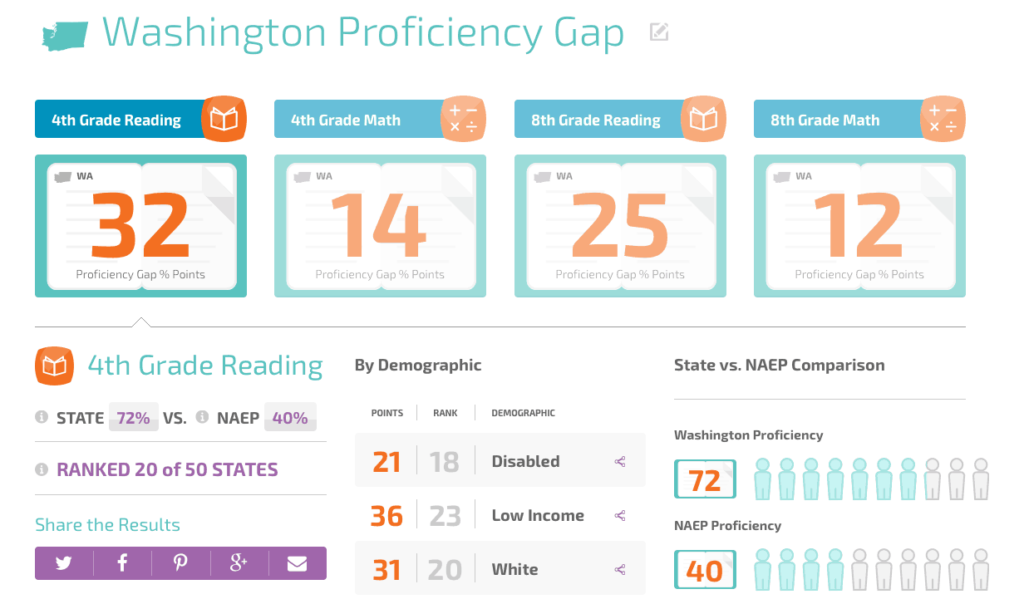Why Authentic Proficiency Matters

The Foundation for Excellence in Education (ExcelinEd) recently launched WhyProficiencyMatters.com–an important resource for parents, families and education stakeholders that will help them better understand what proficiency means, how students in their state are performing and how that impacts their children.
Student proficiency means mastery has been demonstrated in the subject matter, including knowledge, application of knowledge to real-world situations and associated analytical skills. In order to have an honest benchmark of what each student is learning and ensure they’re truly prepared for college and career, accurate proficiency measures are vital.
The Why Proficiency Matters site contains a user-friendly search tool that allows visitors to locate a state’s 4th and 8th grade reading and math proficiency gap percentage points as well as compare the gap based on demographic, view state ranking and compare the state and NAEP. Here’s how my home state scores:
This matters, because there is a serious discrepancy between the National Assessment of Educational Progress (NAEP) expectations and individual state expectations when it comes to proficiency. This means that a state reported proficiency is not equal to proficiency on NAEP, thus creating a dangerous “proficiency gap” that leads parents and teachers to believe students are performing better than they actually are.
In fact, states with large proficiency gaps likely have students who are not on grade level when compared with national or international peers, ultimately resulting in students graduating unprepared for college and career.
Why This Matters for States
In order to raise the bar on proficiency cut scores, ultimately closing the proficiency gap, states must take action. It’s time to review scores and take a close look at student assessments. We must raise expectations for students, but in order to obtain long-term improvement, it is likely we’ll see a slight drop in student scores due to current gaps. WhyProficiencyMatters.com presents the facts and data on expectations for all 50 states, creating a platform for conversation around the importance of high expectations.
Why This Matters for Parents & Families
Families and parents need to be aware of the challenges and opportunities the current proficiency gap create. Realizing the gap exists can initiate importance conversations about multiple ways to measure and track individual student mastery.
If we can create more student-centered learning environments that use adaptive technology and formative assessment to assess skills and pinpoint weaknesses for subject mastery, the gap is bound to shorten and eventually close. There are many resources and strategies educators and school leaders can implement in order to insure students are mastering content, even with new and higher expectations. One tool that comes to mind is i-Ready, from our advocacy partner Curriculum Associates. Using adaptive technology, iReady can pinpoint individual student needs down to skill level, and monitors progress that shows whether students are on track to achieve end-of-year targets. Progress monitoring and adaptive technology also ensures students are truly proficient before they’re advanced onto the next skill level or concept.
Why This Matters for our Country
Here’s a few interesting statistics to consider:
- 23% of 17-20 year olds taking the Armed Forces Qualification test don’t earn a qualifying score;
- 74% of ACT-tested high school graduates fail to score “college ready” in English, reading, math and science;
- First year college students spend $7 billion to learn what they should’ve been taught in high school; and
- There are 600,000 vacant manufacturing jobs due to a lack of qualified applicants.
Do you know how your state ranks? Are you sure your child is getting the help they need to graduate ready for college and career? Visit the site and find out how your state is doing, then start a conversation with friends and families around making sure proficiency cut scores truly reflect knowledge and skills needed for student success.
For more see:









0 Comments
Leave a Comment
Your email address will not be published. All fields are required.